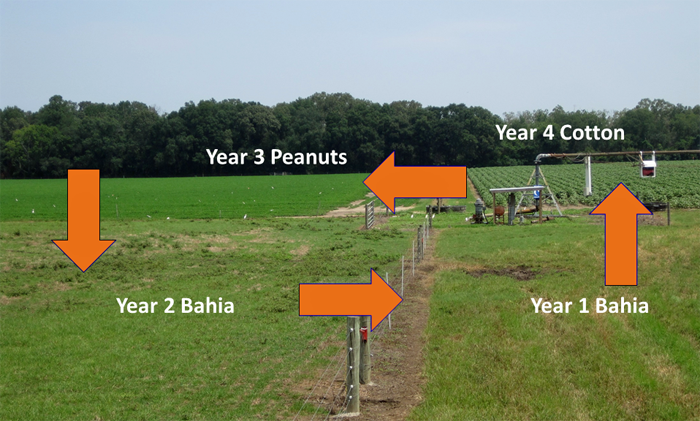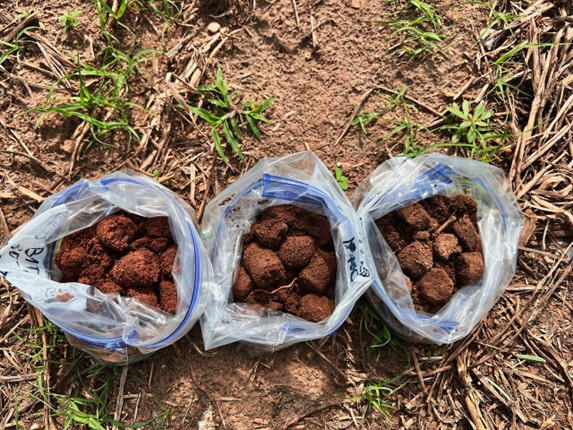J. Portuguez, J. Dubeux, C. Mackowiak, L. Queiroz, , I. Brêtas, K. Trumpp, K. Oduor, M. Bernardini, and M. Ruiz-Moreno, North Florida Research and Education Center
Introduction
Maintaining healthy soil is crucial for sustainable agricultural production and environmental quality. Rotational cropping systems, particularly those integrating livestock, such as integrated crop-livestock systems (ICLS) and sod-based rotation (SBR), have demonstrated significant promise in enhancing soil characteristics and optimizing crop yields. These sustainable practices are recognized for their potential to improve key soil properties like soil organic matter, soil aggregate stability, soil hydraulic conductivity, and soil bulk density.
–
Soil Organic Matter
Soil organic matter (SOM) is one of the most important soil characteristics and directly affects the productivity and environmental responses of agricultural systems. Florida soils are typically sandy, and when combined with a warm climate and high rainfall make it difficult to build SOM. Reducing carbon losses and increasing the inputs of organic residues, both below and above ground, helps to increase SOM. Integration of livestock in cropping systems has helped to increase SOM. Addition of a perennial grass in the rotation improves SOM even further, however, even if the adoption of a SBR is not possible, grazing cover crops during the cool season also helps to improve SOM (Figure 1).

Figure 1. Soil organic matter under different cropping systems. NCC = no cover crop/no grazing; CC-NG = cover crop (oats)/no grazing; CC-NG+34 = cover crop (oats), no grazing, 30 lb N/acre (34 kg N/ha); CCL-SBR = cover crops (oats and crimson clover) in SBR; CCL-SBR+34 = cover crops (oats and crimson clover) in SBR + 30 lb N/acre (34 kg N/ha); CCL-SBR+90 = cover crop (oats) in SBR + 80 lb N/acre (90 kg N/ha).
–
–
Hydraulic Conductivity
Hydraulic conductivity (Ksat) determines the soil’s ability to store and transmit water through its pores. Understanding Ksat is crucial for managing water flow and nutrient transport in agricultural soils. The inclusion of perennial grasses, such as bahiagrass (Paspalum notatum), and livestock in agricultural rotations significantly contributes to the addition of organic matter through root decay and nutrient cycling, enhancing soil physical properties. Including bahiagrass in a cotton/peanut rotation has been demonstrated to improve water infiltration, reducing erosion, runoff, and enhance water holding capacity. These benefits are critical for maintaining soil health and ensuring efficient use of water resources. Our data indicate that integration of livestock improved soil hydraulic conductivity (Figure 3).
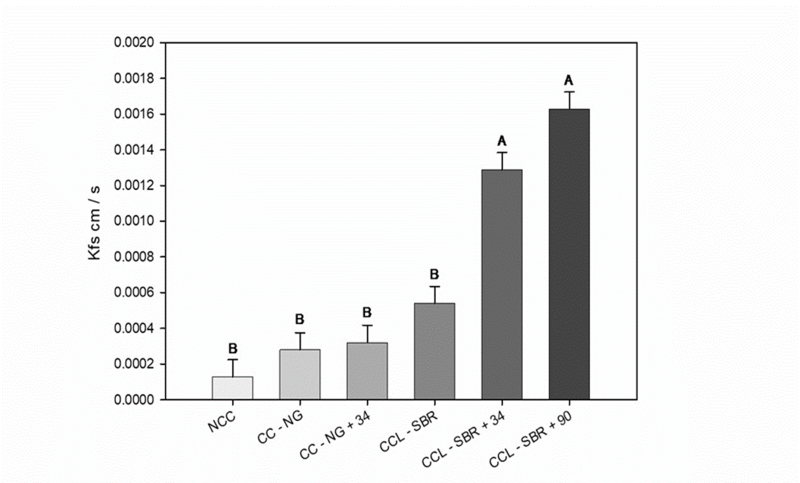
Figure 3. Soil hydraulic conductivity as affected by different cropping systems. NCC = no cover crop/no grazing; CC-NG = cover crop (oats)/no grazing; CC-NG+34 = cover crop (oats), no grazing, 30 lb N/acre (34 kg N/ha); CCL-SBR = cover crops (oats and crimson clover) in SBR; CCL-SBR+34 = cover crops (oats and crimson clover) in SBR + 30 lb N/acre (34 kg N/ha); CCL-SBR+90 = cover crop (oats) in SBR + 80 lb N/acre (90 kg N/ha).
–
Soil Bulk Density
Soil bulk density is an indicator of soil compaction and porosity, affecting water, heat, and gas fluxes within the soil (Rakkar & Blanco-Canqui, 2018). Traditional agricultural practices often lead to increased soil compaction, due to intensive machinery use or overgrazing, negatively impacting crop productivity and environmental sustainability. The absence of soil cover during transitional phases between warm and cool seasons exacerbates these issues, leading to runoff, nutrient leaching, and increased soil compaction. Planting cover crops was key to reducing soil bulk density, and integrating cattle to the cropping systems did not increase compaction (Figure 4). Fallow land was the system that had greatest soil compaction (Figure 4).
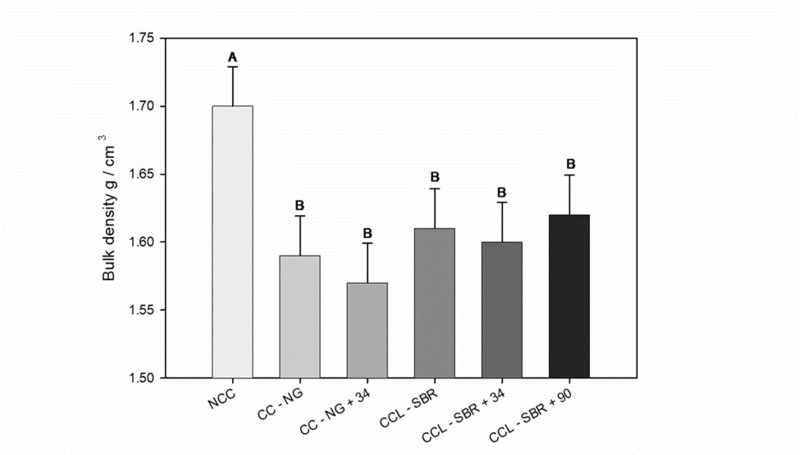
Figure 4. Soil bulk density of contrasting cropping systems. NCC = no cover crop/no grazing; CC-NG = cover crop (oats)/no grazing; CC-NG+34 = cover crop (oats), no grazing, 30 lb N/acre (34 kg N/ha); CCL-SBR = cover crops (oats and crimson clover) in SBR; CCL-SBR+34 = cover crops (oats and crimson clover) in SBR + 30 lb N/acre (34 kg N/ha); CCL-SBR+90 = cover crop (oats) in SBR + 80 lb N/acre (90 kg N/ha).
–
Aggregate Stability
Soil aggregate stability is a critical indicator of soil resistance to physical stresses, affecting its susceptibility to crusting and erosion. Thus, the overall stability of soil aggregates is crucial for sustainable soil management. ICLS has been shown to enhance soil aggregate stability compared to traditional cropping systems without perennial grasses or livestock. Soil aggregation is enhanced by various mechanisms, such as integrating forages into cropping lands, which significantly increases aggregate stability. The formation of stable aggregates is driven by organic binding agents like plant roots and fungal hyphae, both promoted by ICLS. Integrated crop-livestock systems had better soil aggregation when compared to the rest of the systems, the latter leads to improvements in soil structure and SOM. Fallow land, and cover crops with no grazing were the systems with lower soil aggregate (Figure 6).
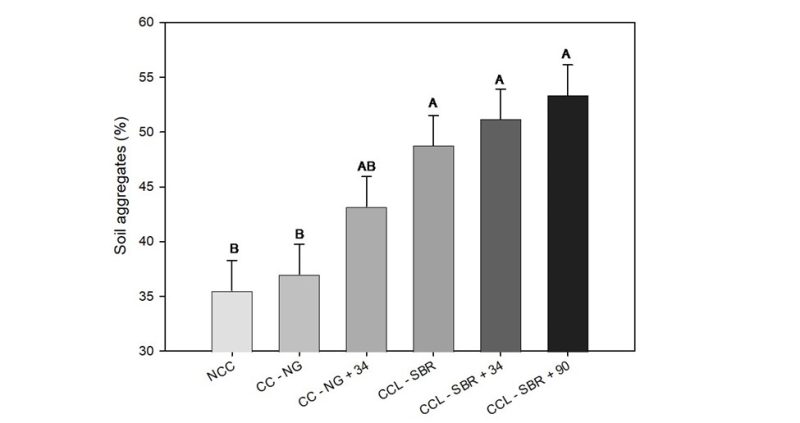
Figure 6. Soil aggregate stability (%) of contrasting cropping systems. NCC = no cover crop/no grazing; CC-NG = cover crop (oats)/no grazing; CC-NG+34 = cover crop (oats), no grazing, 30 lb N/acre (34 kg N/ha); CCL-SBR = cover crops (oats and crimson clover) in SBR; CCL-SBR+34 = cover crops (oats and crimson clover) in SBR + 30 lb N/acre (34 kg N/ha); CCL-SBR+90 = cover crop (oats) in SBR + 80 lb N/acre (90 kg N/ha).
–
Final Considerations
Adopting alternative sustainable systems such as cover crops, livestock integration, and perennial grasses can significantly enhance soil properties. These practices improve SOM, reduce soil bulk density, improve water infiltration rates, and increase soil aggregate stability, fostering healthier and more sustainable agro-ecosystems. The inclusion of perennial grasses and livestock plays a major role in improving soil attributes and promoting plant growth. By integrating these practices, producers can achieve more resilient and efficient agricultural systems, ensuring long-term soil health and sustainability.
–
References
Rakkar, M. K., & Blanco-Canqui, H. (2018). Grazing of crop residues: Impacts on soils and crop production. Agriculture Ecosystems & Environment, 258, 71–90.
- Grazing Cover Crops is a Triple Win! - August 15, 2025
- How are My Cool-season Forages Recovering from the Snowfall and Low Temperatures? - January 31, 2025
- Integrated Crop-Livestock Systems Improve Soil Health - July 26, 2024

